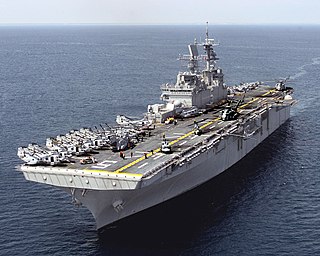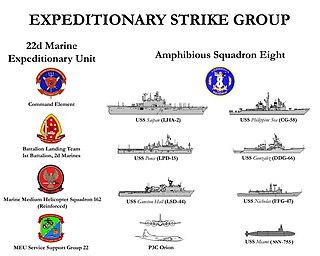
USS Kearsarge (LHD-3) is the third Wasp-class amphibious assault ship of the United States Navy. She is the fifth ship to bear that name, but the fourth to serve under it, as the third was renamed Hornet (CV-12) before launching.

The Wasp class is a class of landing helicopter dock (LHD) amphibious assault ships operated by the United States Navy. Based on the Tarawa class, with modifications to operate more advanced aircraft and landing craft, the Wasp class is capable of transporting almost the full strength of a United States Marine Corps Marine Expeditionary Unit (MEU), and landing them in hostile territory via landing craft or helicopters as well as providing air support via AV-8B Harrier II attack aircraft or F-35B Lightning II stealth strike-fighters. All Wasp-class ships were built by Ingalls Shipbuilding, at Pascagoula, Mississippi, with the lead ship, USS Wasp, commissioned on 29 July 1989. Eight Wasp-class ships were built, and as of June 2018, seven are in active service, as USS Bonhomme Richard was seriously damaged by fire on 12 July 2020, and will be decomissioned and scrapped.

USS Bonhomme Richard (LHD-6) is a Wasp-class amphibious assault ship of the United States Navy commissioned in 1998. Like the previous five Wasp-class ships, Bonhomme Richard is designed to embark, deploy and land elements of a Marine landing force in amphibious assault operations by helicopter, landing craft and amphibious vehicle, and if needed, to act as a light aircraft carrier.

USS Duluth (LPD-6), an Austin-class amphibious transport dock, is the second ship of the United States Navy named for the city in Minnesota.

USS Cleveland (LPD-7), an Austin-class amphibious transport dock, was the third ship of the United States Navy to be named for the city in Ohio. Her keel was laid down at Ingalls Shipbuilding of Pascagoula, Mississippi. She was launched on 7 May 1966, and was commissioned on 21 April 1967 at Norfolk, Virginia. At the time of decommissioning, she was the third-oldest commissioned ship in the US Navy, behind USS Constitution and USS Enterprise (CVN-65).

USS Wasp (LHD-1) is a United States Navy multipurpose amphibious assault ship, and the lead ship of her class. She is the tenth USN vessel to bear the name since 1775, with the last two ships named Wasp being aircraft carriers. She was built by the Ingalls Shipbuilding division of Litton in Pascagoula, Mississippi. Wasp and her sister ships are the first specifically designed to accommodate new Landing Craft Air Cushion (LCAC) for fast troop movement over the beach, and Harrier II (AV-8B) Vertical/Short Take-Off and Landing (V/STOL) jets which provide close air support for the assault force. She can also accommodate the full range of Navy and Marine Corps helicopters, the tiltrotor MV-22 Osprey, the F-35B Lightning II multi-role fighter, conventional landing craft, and amphibious vehicles.

USS Bunker Hill (CG-52) is a Ticonderoga-class guided missile cruiser of the United States Navy constructed by Litton-Ingalls Shipbuilding Corporation at Pascagoula, Mississippi and launched on 11 March 1985. The Ticonderoga-class cruisers are equipped with the Aegis Combat System and Bunker Hill is the first of the class to be equipped with the Mark 41 Vertical Launching System (VLS) in place of the previous ships' twin-arm Mark 26 missile launchers, which greatly improved the flexibility and firepower of the ships by allowing them to fire BGM-109 Tomahawk cruise missiles for land attack missions. Other missions include ballistic missile defence and capital ship escort for anti-aircraft defense. The ship was commissioned on 20 September 1986 and is homeported at Naval Base San Diego in San Diego, California.

HSV-2 Swift is a hybrid catamaran. She was privately owned and operated by Sealift Inc., and was originally built under the JHSV program as a proof of concept. As part of this program, she was directly leased for evaluation from her builders by the United States Navy Military Sealift Command from 2003 to 2013, primarily as a mine countermeasures and sea basing test platform. Later during her official naval career she was mostly used for fleet support and humanitarian partnership missions.

USS Essex (LHD-2) is a Wasp-class Landing Helicopter Dock (LHD) in service with the United States Navy. The amphibious assault ship was built at what is now Huntington Ingalls Industries in Pascagoula, Mississippi. She was launched 23 February 1991 and commissioned on 17 October 1992 while moored at Naval Air Station (NAS) North Island. She is the fifth ship named for Essex County, Massachusetts. Essex served as the command ship for Expeditionary Strike Group Seven until replaced by USS Bonhomme Richard on 23 April 2012.

USS Bataan (LHD-5) is a Wasp-class amphibious assault ship in the United States Navy. The ship is named for the Battle of Bataan in the Philippines, during World War II.

USS Iwo Jima (LHD-7) is a Wasp-class amphibious assault ship of the United States Navy. The ship was named for the Battle of Iwo Jima of World War II. The ship was commissioned in 2001 and is in service.

Landing helicopter assault (LHA) is the United States Navy's hull classification symbol for the general purpose helicopter-carrying amphibious assault ships of the Tarawa and America classes.

USS Rushmore (LSD-47) is a Whidbey Island-class dock landing ship of the United States Navy. She was the second navy ship to be named for the Mount Rushmore National Memorial in the Black Hills of South Dakota. She is the seventh ship in her class of dock landing ships and the fourth ship in that class to serve in the United States Pacific Fleet.

Marine Medium Tiltrotor Squadron 262 (VMM-262) is a United States Marine Corps tiltrotor squadron consisting of MV-22B Osprey tiltrotor aircraft. The squadron, known as the "Flying Tigers", is based at Marine Corps Air Station Futenma, Okinawa, Japan and falls under the command of Marine Aircraft Group 36 (MAG-36) and the 1st Marine Aircraft Wing.

The 31st Marine Expeditionary Unit is one of seven Marine Expeditionary Units in existence in the United States Marine Corps. The Marine Expeditionary Unit is a Marine Air Ground Task Force with a strength of about 2,200 Marines and sailors. The 31st MEU consists of a company-sized command element, a battalion landing team (BLT),, a medium tiltrotor squadron (reinforced),, and a combat logistics battalion. The 31st MEU is based at Camp Hansen, Marine Corps Base Camp Smedley D. Butler, Okinawa, Japan. The 31st MEU is the only permanently forward-deployed MEU, and provides a flexible and lethal force ready to perform a wide range of military operations as the premier crisis response force in the Indo-Pacific region.

The expeditionary strike group (ESG) is a United States Navy concept introduced in the early 1990s, based on the Naval Expeditionary Task Force. The U.S. Navy fields nine expeditionary strike groups and ten carrier strike groups (CSGs), in addition to surface action groups. ESGs allow the U.S. to provide highly movable and self-sustaining naval forces for missions in various parts of the world.

USS Mount Vernon (LSD-39) was an Anchorage-class dock landing ship of the United States Navy. She was the fifth ship of the U.S. Navy to bear the name. She was built in Massachusetts in 1972 and homeported in Southern California for 31 years until being decommissioned on 25 July 2003. Mount Vernon acted as the control ship for the cleanup of the Exxon Valdez oil spill. In 2005, she was intentionally destroyed off the coast of Hawaii as part of a training exercise.
Expeditionary Strike Group SEVEN/Task Force 76 is a United States Navy task force. It is at one and the same time operationally a task force of the United States Seventh Fleet and administratively, the USN's only permanently forward-deployed expeditionary strike group. It is based at the White Beach Naval Facility at the end of the Katsuren Peninsula in Uruma City, Okinawa, Japan.

HMAS Canberra (L02) is the lead ship of the Canberra-class landing helicopter dock in service with the Royal Australian Navy (RAN). It is the current flagship of the RAN fleet. Construction of the ship started in Spain in 2008, with the hull launched by Navantia in 2011. The hull was then transported to Australia in late 2012 for completion by BAE Systems Australia. Canberra was commissioned on 28 November 2014.

Operation Tomodachi was a United States Armed Forces assistance operation to support Japan in disaster relief following the 2011 Tōhoku earthquake and tsunami. The operation took place from 12 March to 4 May 2011; involved 24,000 U.S. servicemembers, 189 aircraft, 24 naval ships; and cost $90 million.




















